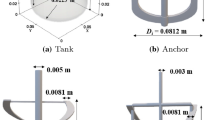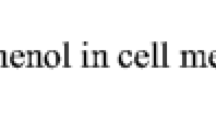Abstract
In this article, two theories are unified to investigate the effect of hydrodynamics on a specific bioprocess: the network-of-zones (NOZ) hydrodynamic structured modeling approach (developed by several researchers but applied to only a few bioprocesses) and the effectiveness factor η approach. Two process scales were investigated (20 and 500 L), and for each, hydrodynamics were quantified using an NOZ validated by homogeneity time measurements. Several impeller combinations inducing quite different hydrodynamics were tested at the 20-L scale. After this step, effectiveness factors were determined for each fermentation run. To achieve this, a perfectly mixed microbial kinetic model was evaluated by using simple Monod kinetics with a fed-batch mass balance. This methodology permitted determination of the effectiveness factor with more accuracy because of the relation with the perfect case deduced from the Monod kinetics. It appeared that for the small scale, η decreased until reaching a value of approx 0.7 (30% from the ideal case) for the three impeller systems investigated. However, stirring systems that include hydrofoils seemed to maintain higher effectiveness factors during the course of the fermentation. This effect can be attributed to oxygen transfer performance or to homogenization efficiency exhibited by the hydrofoils. To distinguish the oxygen transfer from the homogenization component of the effectiveness factor, these phenomena were analyzed separately. After determining the evolution of ηO 2 linked to oxygen transfer for each of the fermentation runs, the NOZ model was employed to quantify substrate gradient appearance. After this step, another effectiveness factor, ηmix, related to mixing was defined. Consequently, it is possible to distinguish the relative importance of the mixing effect and oxygen transfer on a given bioprocess. The results have highlighted an important scale effect on the bioprocess that can be analyzed using the NOZ model.
Similar content being viewed by others
Abbreviations
- d :
-
impeller diameter (m)
- ex :
-
exponential factor of substrate feed pump
- F :
-
fed-batch pump feed rate (m3/s)
- F o :
-
initial fed-batch feed rate (m3/s)
- F max :
-
maximum feed rate (m3/s)
- i :
-
degree of inhomogeneity
- K s :
-
affinity constant (g/L)
- n :
-
number of circulation loops of NOZ model
- N :
-
impeller rotational speed (s−1)
- N qc :
-
circulation without (dimensionless)
- η:
-
circular, number dimensions
- q c :
-
circulating flow rate of NOZ model (q c =Q c /n) (m3/s)
- q e :
-
turbulence backmixing flow rate of NOZ model (m3/s)
- Q c :
-
circulating flow rate (m3/s)
- Re :
-
Reynolds number (dimensionless)
- s :
-
mean absolute deviation
- S :
-
substrate concentration (g/L)
- S a :
-
substrate concentration in the feed (g/L)
- X :
-
biomass concentration (g/L)
- Y xs :
-
substrate-to-biomass conversion yield
- η:
-
effectiveness factor (%)
- ηmix :
-
homogenization component of effectiveness factor (%)
- ηO 2 :
-
oxygen transfer component of effectiveness factor (%)
- μ:
-
viscosity (Pa · s)
- μ x :
-
growth rate (h−1)
- μ xmax :
-
maximum growth rate (h−1)
References
Diaz, M., Garcia, A. I., and Garcia, L. A. (1996), Biotechnol. Bioeng. 51, 131–140.
Mayr, B., Horvat, P., and Moser, A. (1992), Bioprocess Eng. 8, 137–143.
Bylund, F., Collet, E., Enfors, S. O., and Larsson, G. (1998), Bioprocess Eng. 18, 171–180.
Enfors, S. O., Jahic, M., and Rozkov, A. (2001), J. Biotechnol. 85, 175–185.
Lin, H. Y. and Neubauer P. (2000), J. Biotechnol. 79, 27–37.
Neubauer, P., Häggström, L., and Enfors, S. O. (1995), Biotechnol. Bioeng. 47, 139–146.
Cui, Y. Q., van der Lans, R. G. J. M., Noorman, H. J., and Luyben, K. (1996), Trans. Ichem. E 74, 261–271.
Machon, V. and Jahoda, M. (2000), Chem. Eng. Technol. 23, 869–876.
Vasconcelos, J. M. T., Alves, S. S., and Barata, J. M. (1995), Chem. Eng. Sci. 50(14), 2343–2354.
Vrabel, P., van der Lans, R. G. J. M., Luyben, K. C. A. M., Boon, L., and Nienow A. W. (2000), Chem. Eng. Sci. 55, 5881–5896.
Mann, R., Williams, R. A., Dyakowski, T., Dickin, F. J., and Edwards, R. B. (1997), Chem. Eng. Sci. 52(13), 2073–2085.
Vlaev, D., Mann, R., Lossev, V., Vlaev, S. D., Zahradnik, J., and Seichter P. (2000), Trans. Ichem. E 78, 354–362.
Zahradnik, J., Mann, R., Fialova, M., Vlaev, D., Vlaev, S. D., Lossev, V., and Seichter, P. (2001), Chem. Eng. Sci. 56, 485–492.
Norwood, K. W. and Metzner, A. B. (1960), AIChE J. 6(3), 432–437.
Bouaiffi, M. and Roustan, M. (2001), Chem. Eng. Process. 40, 87–95.
Dunn, I. J., Heinzle, E., Ingham, J., and Prenosil, J. E. (2003), in Biological Reaction Engineering, Wiley-VCH Verlag, Weinheim, Germony pp. 77–116.
Oosterhuis, N. M. G. and Kossen, N. W. F. (1983), Biotechnol. Bioeng. 26, 546–550.
Nienow, A. W. (1997), Chem. Eng. Sci. 52(15), 2557–2565.
Pena, C., Galindo, E., and Diaz, M. (2002), J. Biotechnol. 95, 1–12.
Vrabel, P., van der Lans, R. G. J. M., van der Schot, F. N., Luyben, K. C. A. M., Xu, B., and Enfors, S.-O. (2001), Chem. Eng. J. 84, 463–474.
Author information
Authors and Affiliations
Corresponding author
Rights and permissions
About this article
Cite this article
Delvigne, F., El Mejdoub, T., Destain, J. et al. Estimation of bioreactor efficiency through structured hydrodynamic modeling case study of a Pichia pastoris fed-batch process. Appl Biochem Biotechnol 122, 653–671 (2005). https://doi.org/10.1385/ABAB:122:1-3:0653
Issue Date:
DOI: https://doi.org/10.1385/ABAB:122:1-3:0653




